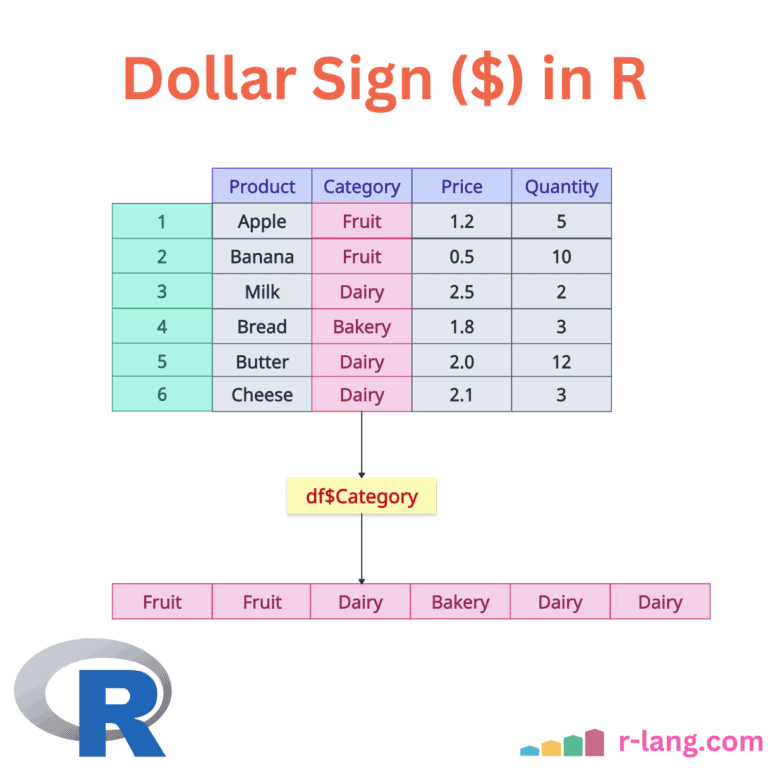In R, you can use the dollar sign ($ operator) to access elements (columns) of a list or a data frame by their name. It also works with your environment. For example, it can fetch you the current environment variables. With its help, you can add, modify, or delete variables from the list and data frame columns.
It is a shorthand for accessing elements without using square brackets ([[]] or []) or other subsetting functions.
Syntax
object$nameIn the above syntax, there are two components:
| Argument | Description |
| object | It represents the R object that contains named components. |
| name | It defines the name of the element to extract or assign. |
For assignment
object$name <- value
| Argument | Description |
| value | It declares the value that needs to be assigned to the named component. |
Accessing the element of a list by name
The $ operator requires the exact name of the component and is case-sensitive. It does not support partial matching by default unless options(check.names = FALSE) is set, which is rare.
Figure: Usage of $ sign
list_a <- list("PS5" = "Miles Morales", "Xbox" = "Halo Infinite")
list_a$PS5
# Output: [1] "Miles Morales"The above output shows that it extracted and returned a single component in its native type.
Adding a new variable to a list
Let’s add a named element to the list. This helps create a dynamic list you can add to or modify.
list_a <- list("PS5" = "Miles Morales", "Xbox" = "Halo Infinite")
print(list_)
print("After adding a variable to a list")
list_a$Nintendo <- "Legend of Zelda"
print(list_a)Output
$PS5
[1] "Miles Morales"
$Xbox
[1] "Halo Infinite"
[1] "After adding a variable to a list"
$PS5
[1] "Miles Morales"
$Xbox
[1] "Halo Infinite"
$Nintendo
[1] "Legend of Zelda"Removing an element from the list
To delete the variable or name from the list, you can set it to “NULL”.
list_a <- list("PS5" = "Miles Morales", "Xbox" = "Halo Infinite")
list_a$PS5 <- NULL
list_a
# Output:
# $Xbox
# [1] "Halo Infinite"Adding a column to the data frame
Data Frames are list-like objects where each column is a named component. That’s why you can use the $ sign on it.
Add a new column “col4” to the existing data frame by assigning a new column name to a data frame using $ and assigning the values using the <- operator.
df <- data.frame(
col1 = c(1, 2, 3),
col2 = c(4, 5, 6),
col3 = c(7, 8, 9)
)
df$col4 <- c(10, 11, 12)
print(df)In the above output figure, we specifically mentioned using a red-bordered rectangle to indicate that a new column has been added to an existing data frame. You can also update an existing column with new values.
Accessing the column of the data frame
Since each column is named list, you can retrieve a specific element (value) from a named list (column of the data frame).
df <- data.frame(
col1 = c(1, 2, 3),
col2 = c(4, 5, 6),
col3 = c(7, 8, 9)
)
print(df$col2)
# Output: [1] 4 5 6Deleting the column of the data frame
If you assign NULL to a specific column, it will be removed from the data frame because it now has no value and does not add anything new.
df <- data.frame(
col1 = c(1, 2, 3),
col2 = c(4, 5, 6),
col3 = c(7, 8, 9)
)
df$col2 <- NULL
print(df)Accessing objects in an environment
If you have defined your custom environment, the $ sign will help you retrieve the environment variable.
# Creating an environment
env <- new.env()
env$var <- 21
# Accessing 'var'
value <- env$var
print(value)
# Output: [1] 21
It helps manage the global state of our application.
Using $ with Packages
R provides many built-in packages; you can choose one and access a function or dataset from a loaded package.
# Access a dataset from the 'datasets' package
head(datasets::mtcars$mpg)
# Output: [1] 21.0 21.0 22.8 21.4 18.7 18.1In the above code, the datasets::mtcars$mpg uses $ to access the mpg column from the mtcars dataset.
Limitations: Dynamic Names
The $ operator is somewhat limited in programmability. For example, you can’t easily use a variable to specify a column name when using $. In such cases, alternative methods like “[[“ or “[“ are more appropriate.
The $ does not evaluate variables as names, requiring [[ for dynamic access. This is a key limitation when column names are stored in variables for the $ operator.
Non-Existent Names
If you attempt to access a non-existent element in the list, it will return NULL.
If you attempt to access a non-existent column in the data frame, it will also return NULL.
Here is the code:
list_a <- list("PS5" = "Miles Morales", "Xbox" = "Halo Infinite")
print(list_a$PS4)
# Output: NULL
df <- data.frame(
col1 = c(1, 2, 3),
col2 = c(4, 5, 6),
col3 = c(7, 8, 9)
)
print(df$col4)
# Output: NULLThat’s it.

Krunal Lathiya is a seasoned Computer Science expert with over eight years in the tech industry. He boasts deep knowledge in Data Science and Machine Learning. Versed in Python, JavaScript, PHP, R, and Golang. Skilled in frameworks like Angular and React and platforms such as Node.js. His expertise spans both front-end and back-end development. His proficiency in the Python language stands as a testament to his versatility and commitment to the craft.









